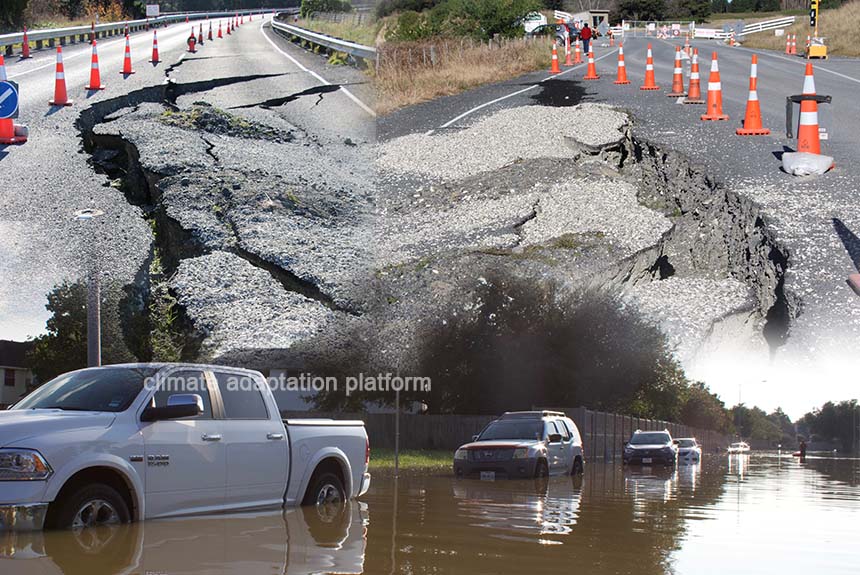Natural events impacting transportation assets have become more frequent and catastrophic, resulting in significant damage, economic losses, social isolation, and adverse cascading effects on other critical networks that strongly depend on transportation systems.
For instance, Hurricane Dorian, which hit The Bahamas in 2019, resulted in more than $87 million in damages and losses in the transportation sector alone. In New Zealand, the 2016 Kaikoura earthquake caused massive damage to its transport-related infrastructure, estimated to cost more than US$600 million to rebuild. Damages to its road infrastructure have also lengthened travel times in the region, which has a direct economic consequence.
The increasing frequency and severity of extreme natural events and disasters and their cascading impacts on critical infrastructure highlight the importance of integrating risk and resilience into transport asset management.
A paper published in the Structure and Infrastructure Engineering in September 2023 by researchers from the University of Auckland in New Zealand and Universities in Chile – Pontificia Universidad Catolica de Chile, and Universidad de Concepcion, presented the main approaches to quantify resilience and risk and how they incorporate hazard models into transportation asset management.
The International Organization for Standardization (2014) established that asset management involves a continuous process that spans the entire life cycle of an asset. Asset management integrates engineering practises and models to optimise limited resources and help transportation agencies implement budget allocation programmes for the best long-term benefits.
According to the paper, although many countries and institutions have incorporated resilience and risk to natural hazards into their transportation asset management (TAM) systems, one of the main challenges of this integration is the lack of standard procedures.
Through a systematic literature review, the authors explore how resilience and risk have been integrated into transportation asset management to mitigate the effect of natural events on civil infrastructure.
The review included literature that recognises the need for integrating resilience and risk into transportation asset management (TAM), proposes metrics to aid decision-making in TAM, or presents methods to incorporate them into TAM. The authors observed that the need to integrate resilience and risk into transportation asset management has steadily grown, and so have the papers covering the subject.
The integration of resilience and risk into TAM has been studied from various perspectives and contexts, but for this paper, the authors have categorised their findings into four major groups:
First, the integration requirements and policy guidelines describe the legislative requirements adopted by different countries and departments of transportation and also present a series of policy guidelines and recommendations to reduce the effects of natural hazards on transportation infrastructure. Second, consequence modelling presents a series of models used in TAM to quantify damage and losses; Third, resilience metrics explore the most frequent approaches for transportation resilience assessment linked to TAM; and Fourth, integration methods explore the different integration methods proposed in the literature.
The review of related literature also revealed the two main approaches used to evaluate natural hazard’s effect on transportation infrastructure:
The first approach evaluates consequences using deterministic metrics, which usually do not consider sources of uncertainties. In contrast, the second approach involves probabilistic methods to account for potential hazard analysis and structural response uncertainties.
TAM has traditionally focused on evaluating asset performance over time based on their exposure to heavy vehicle loading and routine weather events, neglecting the effects of natural hazards in the analysis. For example, pavement deterioration studied for decades can confidently estimate an asset’s life cycle performance. However, the long-term effects of natural hazards can also contribute to the decline of the asset, reducing its useful life.
The review also presents the potential effects of natural hazard events on transportation assets. Most authors included physical damage as the only consequence based on reconstruction costs. However, others argue that analysis should also have indirect implications from interrupted road networks, travel time delays, increased CO2 emissions, social impacts, or extra operational costs.
The author notes, therefore, that future research in the field should include improvements in resilience and risk modelling, indirect consequences of interrupted road networks, the long-term effect of natural hazard events on asset performance, and improvements in the integration of resilience and climate change into TAM.
In summary, transportation agencies need to improve their modelling of the uncertain consequences of natural hazard events and integrate resilience into TAM to accurately estimate their investments’ benefits.
Finally, the study states that only considering transportation-related physical consequences as benefits of resilience investment can lead to an underestimate of the true benefits.
Read more about the study by clicking the link in the “Source” section below.
Source:
Allen, E., Costello, S. B., Henning, T. F., Chamorro, A., & Echaveguren, T. (2023). Integration of resilience and risk to natural hazards into transportation asset management of road networks: a systematic review. Structure and Infrastructure Engineering, 1-19.



Leave a Reply